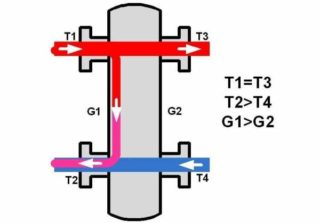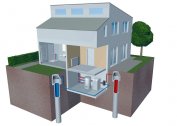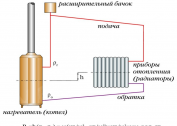A hydraulic arrow in the heating system or a flow separator is a special device used for the coordinated operation of the devices and circuits included in it. It is a kind of collector that regulates the pressure of the liquid in each of the water channels. The device got its name due to the functional similarity with the railway arrow.
Advantages and disadvantages
The advantages of hydraulic valves for heating systems include:
- obtaining the optimal ratio of coolant flows in the forward and reverse pipelines;
- the possibility of installing a low-power circulation pump - reducing the cost of equipment and electric energy;
- reduction of hydraulic loads in the elements of the heating system;
- extension of service life;
- the ability to remove air from the channels.
There are no obvious flaws in the hydraulic separator. But there are some limitations in practical application. The disadvantages of these devices include:
- inadmissibility of work as part of the equipment of solid fuel boilers;
- the impact on the functionality of the arrow of the declared power of the boiler unit - with its increase, the reliability of its operation decreases.
The time of trouble-free operation of the product in this case is also reduced.
Separator device
Externally, the separator looks like a pipe segment having a rectangular (more rarely, round) section and two plugs at its opposite ends. This design is connected to the boiler with small nozzles and has a few taps in the side. On sale there are products of various shapes and sizes, having a simple device. But there are universal models that, according to their purpose, perform two functions at once: a collector and a stream splitter.
The "classical" hydraulic arrow for heating is made in the form of a steel cylinder and has several branch pipes, the size of which is taken into account according to the internal section. Usually it is mounted vertically, but if necessary, can be installed in a horizontal plane. The vertical arrangement is used more often, since in this position it is easier to remove impurities and remove gases.
In most cases, the arrow is a welded construction based on steel pipes, but the option of its manufacture from copper or polypropylene billets is not excluded.
Additional features
Features of the functioning of the heating circuit with a hydraulic arrow provide the user with such additional features:
- When a fluid stream enters the separator channels, its speed decreases somewhat. This contributes to the sedimentation at the bottom of harmful impurities that are always present in the coolant.
- For periodic removal of accumulated sediment in the lower part of the housing there is a separate valve.
- Reducing the speed of the current allows you to remove the air bubbles in it from the water. They are removed through an automatic valve.
In the latter case, the hydraulic needle is used as a separator.
In networks with cast-iron boilers, the flow distributor performs the function of additional protection. If there is a water separator, cold water will not enter the heat exchanger, which can cause damage to the heating elements.
Principle of operation
Heating networks are not able to function smoothly, since the circuits are designed for individual performance and a specific indicator for the pressure of the medium. The principle of operation of the hydraulic arrow is based on design features due to which the resistance to water flow is minimal at the device body. This property allows you to not reduce the speed of movement of the media, significantly reducing heat loss in the entire network.
In fact, the distributor is a kind of buffer separating the heating equipment (boiler) and the consumer part of the collector. As a result of its application, each individual pump operates autonomously without disturbing the balancing of the channels.
The hydraulic separator for heating is designed to separate individual flows from the total circuit and coordinate their joint work.
Separator Calculation Methods
Before installing a water gun, the calculation of individual structural elements is mandatory. When conducting it, the following factors should be taken into account:
- heat carrier consumption in a working system;
- thermal power developed in each circuit.
In the calculations, the heat capacity of the working fluid and the temperature difference of the aqueous carrier in the return and supply channels are also taken into account. The required result is calculated by the following formula:

where D is the desired diameter of the product, Q is the average value of the flow rate of water (m3 / s), π is the classical constant, and V is the velocity of the liquid flow in the vertical direction (at a rate of 0.1 meter second).
When self-assembling the arrows and calculating the optimal parameters, they act according to the scheme obtained experimentally:
- To find the inner diameter, the sum of all the capacities of the working boiler in kilowatts is taken and divided by the difference in temperature indicators in direct supply and in return.
- You will need to extract the square root from the result, and then multiply the result by the number 49.
- To find the size of the gap between the nozzles, multiply the inner diameter by two.
To determine the height of the distributor housing, the same diameter is multiplied by six.
Combined water gun
To connect the heating circuits at facilities with an area of more than 150 m² instead of the usual separator, which turns out to be bulky, special combs are used. They are a sequential design that combines the capabilities of a hydraulic boom and a collector for heating, which are connected with steel jumpers for this. The number of twin pipes is selected equal to the number of circuits (they will be required for a pair of pieces). The advantages of this combination include:
- The repair and maintenance of the entire heating system is simplified. The small construction does not take up too much space in the room.
- The locking, as well as the regulatory part of the reinforcement kit can be placed in one place.
- Due to the increased diameter of the collector channel, the thermal carrier is evenly distributed along the contours.
For this arrangement, this approach uses special mounting outlets, some of which are designed for the radiator circuit, and another for connecting floor heating.
The features of the combined design include the presence of a special heat exchanger, as well as the installation of a separate balancing valve between the direct and return manifolds.
Self-made order
To assemble the arrows for do-it-yourself heating, first you need to carry out theoretical calculations, after which drawings and work diagrams are prepared.This part of the preparatory measures is best entrusted to a heating engineer who possesses the necessary theoretical training. A person who decides to make an arrow with his own hands, must have the skills to conduct welding.
The assembly of any modification of the hydraulic switch is based on the “3 diameters” rule. The working size of the nozzles is chosen three times less than the diameter of the main cylinder of the distributor. They are located diametrically opposite, and their height location is tied to the main caliber. A variant is possible in which the bends are made by the so-called "ladder", which allows to increase the efficiency of gas removal and removal of insoluble suspensions. In addition, the choice of such a design for self-assembly contributes to the normal mixing of flows.
The ratio of their locations is best chosen in such a way that the speed of movement of the vertical flow reaches 0.2 meters per second. According to current regulations, this limit is unacceptable, because then the water flows do not have time to mix. And this is fraught with the appearance of a temperature gradient and deterioration of the distribution conditions of the flows.
If you plan to make a multi-circuit heating system with different temperatures of the coolant, you will have to assemble a combined arrow (together with the collector).
In this case, it is preferable to choose a horizontal scheme, which, unlike the vertical counterpart, is not so common among amateurs and professionals. But in this situation, questions of the efficiency of the operation of the heating system come first, and not the convenience of its maintenance, cleaning and repair.








